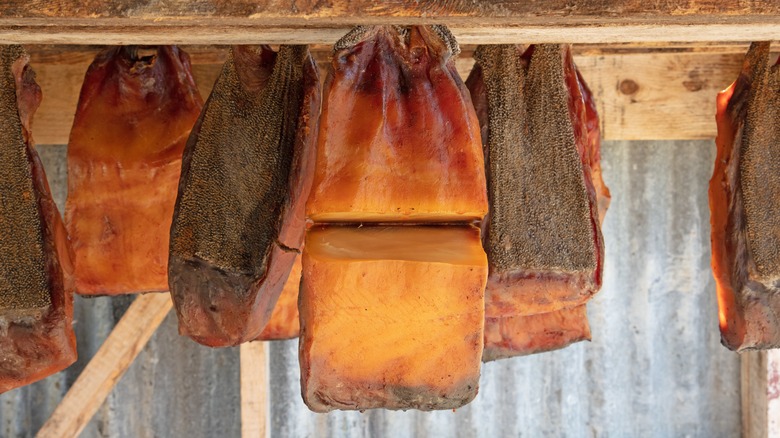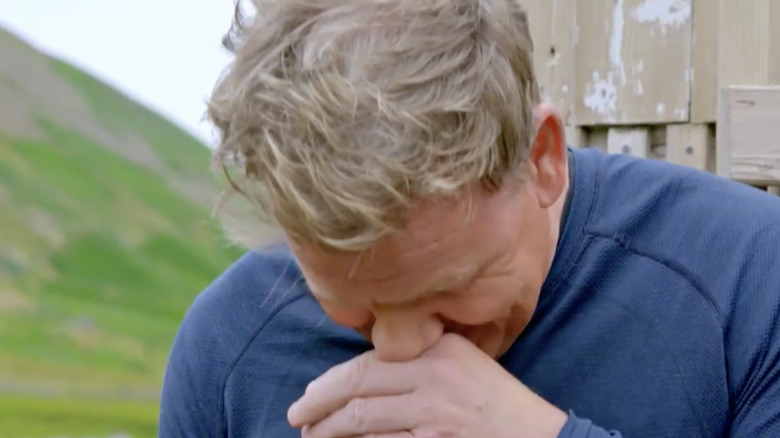The Traditional Icelandic Dish Gordon Ramsay Couldn't Handle
An island nation far north of the European region of Scandinavia, Iceland is among the most isolated, well-inhabited places on Earth. Settled thousands of years ago and with its still intact parliament first assembling in 930 A.D., the former territory of Denmark historically enjoyed an insular culture of self-sustainment, the people living off of and developing whatever grew or lived in and around Iceland. As a result, traditional Icelandic cuisine is like no other country's, built around fish and seafood prepared in ways that could thwart the punishing climate of the region.
Each mid-winter, according to the government of Iceland, Icelanders celebrate a festival called Thorrablot. Once a pagan sacrificial event, it was revived in the 19th century as a celebration of Iceland's history, culture, and food. According to Nordic Visitor, one of the star dishes of the party is hákarl, an arduously prepared dish with a taste, texture, and makeup that could be considered challenging to contemporary diners. It's certainly unlike anything anyone would find at even the most progressive or creative seafood restaurants. Most adventurous professional eaters might be unable to handle it — even chef, restaurateur, and food television host Gordon Ramsay.
Hákarl, or fermented shark, figures large in Icelandic food history
According to Atlas Obscura, the sharks that swim around Greenland and Iceland can reach 24 feet in length. That's a lot of meat on one shark, but it can't be eaten fresh or prepared traditionally because it's poisonous. However, about 1,000 years ago, Vikings in the Iceland area discovered that the offending toxins could be removed from the shark meat — by cutting it into large chunks, placing it under rocks, and burying the whole mess in the dirt for many weeks. Then, they'd remove the meat from its hole in the ground and hang it to age. The final product is called hákarl, essentially slow-fermented shark meat.
Only the toxic elements of the shark work themselves out. There's still plenty of uric acid sticking around in the flesh, giving hákarl a distinctively pungent smell similar to ammonia. The uric acid certainly contributes to an aftertaste that sticks around — reportedly reminiscent of urine and which will dissipate with a shot of Brennivin, a caraway-flavored Icelandic spirit. But between the smell and the aftertaste is the taste and texture of the shark meat itself.
Gordon Ramsay was unable to even swallow a piece
Icelanders can feasibly prepare hákarl at any time, not just during the mid-winter festival of Thorrablot. In 2021, Gordon Ramsay's National Geographic food travelogue series "Uncharted" took him to Iceland, where he came face-to-face with one of the few foods to ever truly and completely unnerve the chef that has tasted mountains of what looked to be stomach-churning food prepared by incompetent chefs on "Hell's Kitchen" and "Kitchen Nightmares." Ramsay didn't even want to try hákarl, but he was duty-bound.
"I'm in Northwest Iceland sampling a pungent slice of fermented shark that I'm not convinced is meant to be eaten," Ramsay said while introducing the segment of the "Uncharted" episode (via People). After giving himself a little pep talk to muster up the courage to go for a taste, Ramsay placed a small piece of hákarl in his mouth and immediately and emphatically spat it out. The fermented shark was only on his tongue for a second or so (and helped along with a shot glass of an alcoholic spirit), but that proved long enough for Ramsay to get the gist and to register an opinion. "My nose is all fizzy," he explained before declining a second, smaller serving from his hosts.


